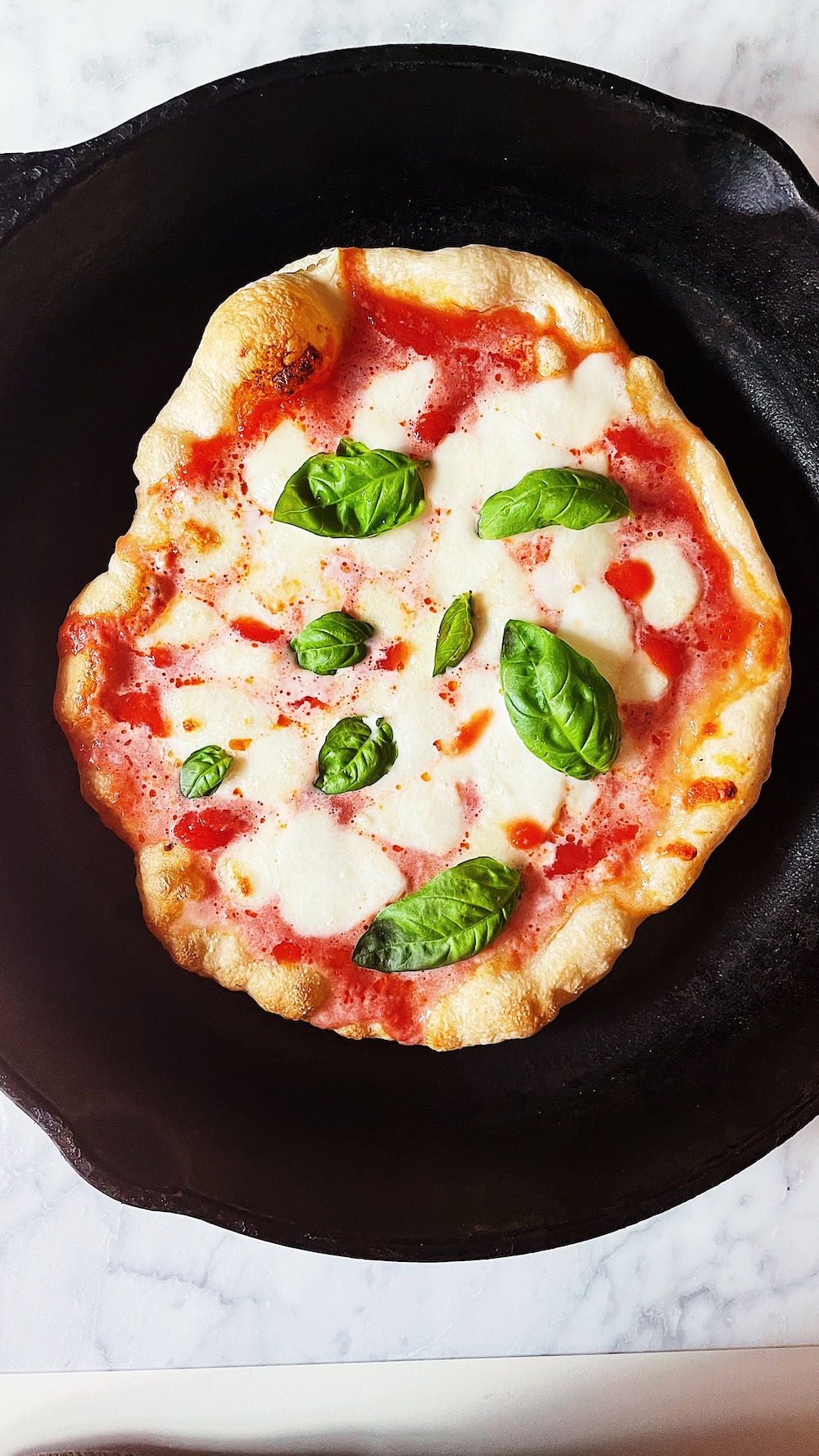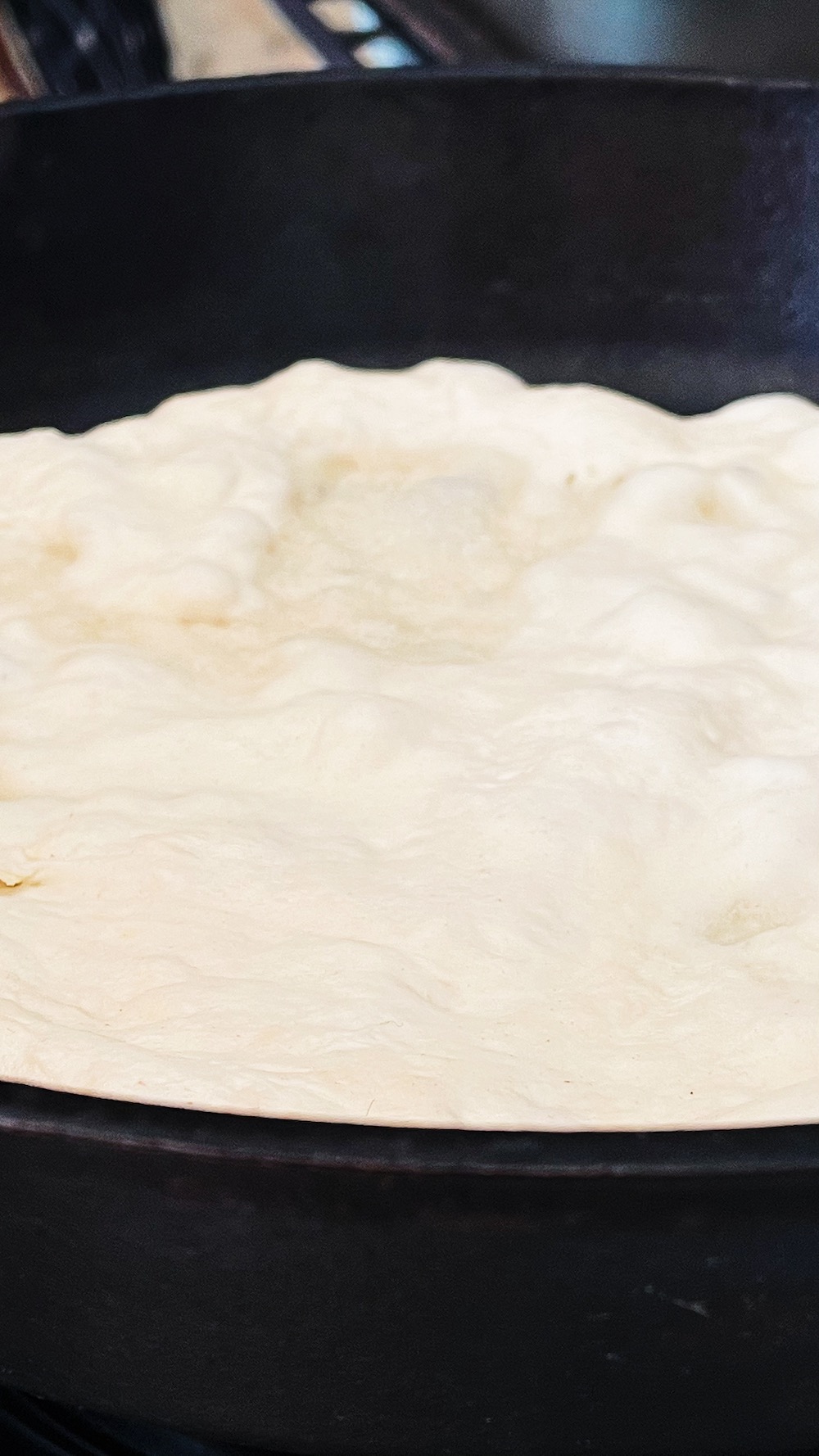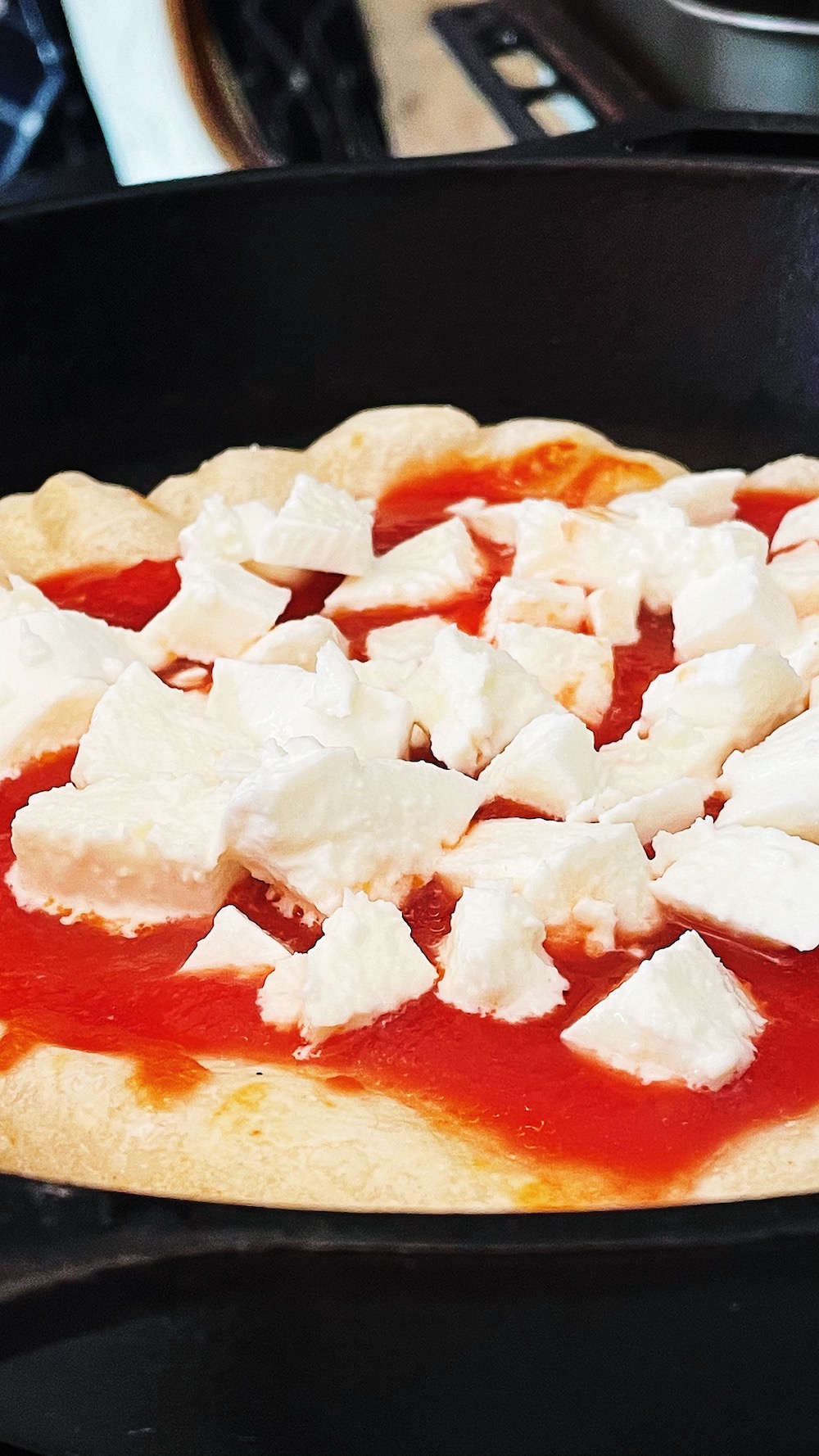In this post, I’m sharing a proper Italian pizza dough recipe with fresh baker’s yeast. And how to cook pizza in the home oven – there’s a short stovetop step – with a cast-iron skillet.
ITALIAN PIZZA AND PIZZA DOUGH
In Italy, there’s a main, fundamental distinction between pizzas: “bassa”, the thin crust pizza, and “alta”, the thick one. The first is usually referred to as the pizza “romana”. It is flatter, and borders are crunchy, sometimes a bit burned. The second, the “napoletana”, is chewy and has puffed edges.
The best pizzas, regardless of thickness, are the ones cooked in wood-fired ovens, where the temperature reaches up to 450°C (842°F). The professional electric ovens, which also give decent results, reach 350°C (662°F). There are small domestic versions. But I don’t have one and wouldn’t possibly find space for it in my tiny apartment.
BAKING THE PIZZA DOUGH IN A CAST-IRON SKILLET AT HOME
I’ve tried many no-fail promised recipes of pizza dough. The dough rose and rose, but once in the oven, all the efforts were gone. The home oven temperature, which maximum reaches 250°C (482°F), was never enough. So I gave up for a long time.
I did specialize, however, in other regional pizza recipes and made a decent collection for the Italian Spring’s Simposio!
Then I found a Pinterest picture showing an obviously homemade pizza with a puffed crust and perfect baking results. It promised it was possible, and for once in the blogosphere, Simona was telling the truth!
I had tried the cast-iron skillet trick, and it gave decent results, but not enough to make me give up my trusted pizzeria delivery. Which I still haven’t given up, but which I’m calling much less often.
The crucial step I was missing, and Simona taught me, was the stovetop.
After preparing the dough, letting it rise overnight in the oven, forming the single-serving loaves, and, again, letting them rise, I roll out the dough with my hands, giving it more or less the shape and dimension of the cast-iron skillet. Before transferring it to the pan, I heat the latter on the stovetop until scorching – THIS IS THE TRICK. When I cautiously lay it on the skillet, the heat pumps the leavening: bubbles appear and disappear, and the borders rise.
After a minute, I put a few spoonfuls of tomato sauce, bake the pizza in the oven’s highest rack for a bit, get it back to add mozzarella, and finalize the baking.
With this dough recipe and baking method, you’ll get a pizza in-between the thin and the fluffy crust pizza. The more you roll out the dough and make it thinner, the flatter the pizza, of course. But the borders will puff, and on the inside, you’ll see the bubbles formed and the air let in during leavening. It is greatly digestible and a pleasure to each bite.
THE ITALIAN PIZZA DOUGH RECIPE
Rising the dough at home is another issue. You need a little trick to urge yeast’s activation, which is simply adding a bit of sugar and a bit of olive oil, nourishment for bacteria.
Fresh baker’s yeast is the best option unless you opt for sourdough, but that’s a whole other story, far from routine life.
I use a mixer with the kneading hook on; it is fundamental as you need to work the flour a lot to get a glutinous, elastic dough. You can, of course, work it with your hands; it just takes double the time, so about forty minutes.
You need 0 flour, rich in gluten, for elasticity.
Don’t worry if, before leavening, the dough appears sticky: it means moisture, so a better rising and a fluffier crust.

Italian pizza dough recipe
Ingredients
- 17.6 oz 0 flour - 500 gr
- 6.7 oz hot tap water + something more - 250 ml
- 0.4 oz fresh baker's yeast - 12 gr
- 2 teaspoons sea salt - 10 gr
- 3 teaspoons sugar - 10 gr
- 3 tablespoons extra virgin olive oil - 30 gr
Instructions
-
Dissolve the yeast and the sugar in the hot tap water. Let it rest for five minutes in a warm place. During winter, I place it in the oven with the light on, and if it's not enough, I set the temperature to 68-86°F (25-30°C). After five minutes, you should see a slight bubbling, even just a hint on the sides. This means the yeast is active. If not, start all over again.
-
Add the olive oil to the yeasted water and mix well.
-
Place the salt on the bottom of the mixer's bowl. Add the flour too.
-
Initiate the engine, slow speed, and gradually pour in the yeasted water. Work the dough for about ten minutes; you'll see it coming together and collect all the flour from the bowl sides.
-
After ten minutes, add circa 1.7 oz (50 ml) more hot tap water, and work the dough: it will wrap itself around the hook after about five minutes. Timing depends on the flour quality and gluten.
-
Add about 0.7 oz (20 ml) of hot tap water. At this point, the dough will go back to almost liquid, but don't worry, keep kneading, always low speed, until it wraps around the hook once more. The result will be a soft and sticky dough.
-
Remove the hook and cover the bowl with a kitchen cloth. Place it in a warm spot of your house - away from drafts and temperature swings - or in the light-on or low-temperature oven, 68-86°F (25-30°C). I keep the oven on for four to six hours, then turn it off and leave the dough rising overnight. Try to get close to this.
-
The next day, take back the bowl, pour the dough over a lightly floured working surface and grease your hands with a bit of olive oil. Don't worry if the surface of the dough has dried a bit: it happens. Work the dough with your hands, shortly, and form four round, same-size loaves.
-
Cover them with the kitchen cloth and let them rise for at least a couple of hours.
TOOLS AND INGREDIENTS USED IN THIS RECIPE:
THIS LIST INCLUDES AFFILIATE LINKS.
HOW TO BAKE PIZZA WITH THE CAST IRON SKILLET METHOD – PIZZA MARGHERITA!
Pizza Margherita is the basic, tomato sauce, mozzarella, and fresh basil leaves, Italian favorite. You can add toppings like Prosciutto Crudo – after baking, I beg you! – olives, mushrooms, etc., and use buffalo mozzarella or burrata instead of Fiordilatte, plain mozzarella. But it is important to dry the mozzarella from the excess milk: simple as dicing it and placing it in a colander for at least half an hour.
The cast-iron skillet method is also great for store-bought pizza dough. In Italy, we order our “panetti”, loaves, at neighborhood bakeries or pizzerias. With the skillet, the results are a thousand times better than simply rolling out and baking the pizza in the house oven!

Cast Iron Skillet Italian Pizza
Ingredients
- 1 loaf pizza dough about 7-9 oz - 200-250 gr
- 100 - 125 gr mozzarella
- 4-5 tablespoons tomato paste - passata
- olive oil
- salt
- 3-4 basil leaves - fresh
Instructions
-
Dice the mozzarella into small pieces, place it in a colander or a fine-mesh sieve in the sink or over a bowl to collect liquids. Let it release the extra milk for at least half an hour.
-
Preheat the oven to the maximum, mine arrives at 482°C (250°C), and place the rack on the upper level.
-
Place the tomato paste in a bowl and season it with half a teaspoon of olive oil and a pinch of salt. Mix well, and set aside.
-
Clean the basil leaves and set them aside.
-
Take the pizza dough loaf and place it on a lightly floured surface. With your hands greased with a few drops of olive oil, work the dough with your fingertips, gently, to form a pizza base the shape, or almost, of your skillet.
-
Place the cast-iron skillet on the stovetop, high heat, and wait until it becomes scorching - about five minutes.
-
Delicately and carefully, transfer the pizza base to the skillet with both hands. Cook one minute. You'll see the dough puffing all around the surface.
-
Add the tomato sauce, a spoonful at the time, and spread it, with the back of the spoon, all over the surface - but not the edges.
-
Transfer the skillet to the oven and bake the pizza for one minute.
-
Take it back, scatter the mozzarella evenly on the surface, and immediately return the skillet to the oven.
-
Bake it for four to six minutes. With the help of a spatula, lift the pizza and check the bottom; when golden, your pizza is ready. With time you'll get to know your oven and know exactly the time needed.
-
Take the pizza out of the oven and garnish it with the basil leaves.
-
Repeat for all your pizzas.
Recipe Notes
We usually eat all from the same pizza once out of the oven, while the following is baking.
TOOLS AND INGREDIENTS USED IN THIS RECIPE:
THIS LIST INCLUDES AFFILIATE LINKS.
Enjoy your Italian pizza dough recipe, and let me know all the fantastic variations you’ll create!
Claudia
















